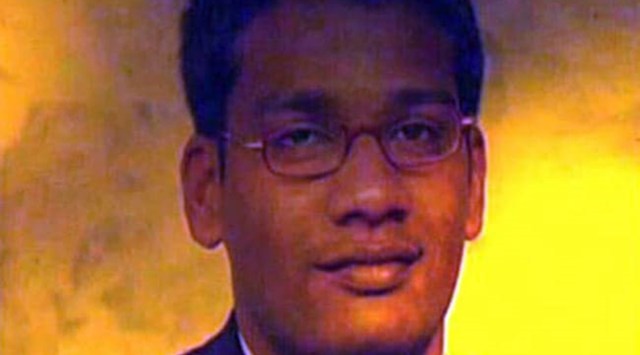IOC’s Manjunath murder: Serving life, convict walks free after 17 yrs
IIM Lucknow graduate, 27-year-old Manjunath, was killed in 2005 for exposing corruption and an oil adulteration racket in Lakhimpur Kheri where he was posted.
 Manjunath was to report on irregularities at petrol pump
Manjunath was to report on irregularities at petrol pump Serving a life sentence, a 43-year-old murder convict of Indian Oil Corporation sales manager S Manjunath stepped out of jail last Sunday after the Uttar Pradesh government ordered his premature release.
IIM Lucknow graduate, 27-year-old Manjunath, was killed in 2005 for exposing corruption and an oil adulteration racket in Lakhimpur Kheri where he was posted.
“A year back, the proposal for consideration of premature release of convicts Shivkesh Giri alias Lalla Giri and Vivek Sharma (44) was sent to the state government. After legal process, government ordered the premature release of Lalla Giri. We released Lalla Giri on January 8 this year. The proposal of Vivek Sharma for premature release is pending,” Vipin Mishra.Superintendent, Lakhimpur Kheri district jail, told The Indian Express.
“Lalla Giri and Vivek Sharma had completed jail term of around 17 years. Because of Lalla’s good conduct inside the jail, his jail term with remission period added up to about 22 years,” said Mishra. Giri was charged with the destruction of evidence.
Giri and Sharma are among the six accused serving life terms for Manjunath’s murder. Prime accused Pawan Mittal alias Monu Mittal and other accused Devesh Agnihotri, Rakesh Anand and Rajesh Verma are in Bareilly jail.
The case dates back to November 20, 2005, when Sitapur police stopped a car near Green Dhabha in an area under Maholi police station. Searching the vehicle, police found a body on the rear seat. The two occupants of the car, Rakesh Anand and Vivek Sharma, were taken into custody for questioning. Sharma was driving the vehicle.
The body of Manjunath was identified by a Lakhimpur Kheri resident, who was passing by and had stopped at the spot after seeing a crowd.
Police found that on the night of November 18, 2005, Manjunath had booked a room at a hotel in Gola Gokaran. The next day, he went to Mittal pump for an inspection and found alleged irregularities. The petrol pump was owned by Sulakshan Mittal, father of Monu Mittal.
Manjunath told the petrol pump owner that he would send his inspection report to headquarters. Incidentally, this was the second time irregularities were found at this pump – earlier, the pump was sealed for a month and opened only after the owner paid a fine of Rs 70,000.
Police said that after Manjunath’s warning, Monu Mittal was wary of losing his licence – a possibility after a second negative report — and so decided to “eliminate” Manjunath before he could file his report.
Incidentally, on November 19, before leaving Mittal petrol pump, Manjunath left the measuring instrument there, the one he had used to check the fuel for adulterants. Manjunath went to another petrol pump to watch a cricket match.
Police said, at around 9.30 pm, Manjunath returned to Mittal’s pump from where an employee called up Monu who arrived in 10 minutes later with friend Agnihotri. They accompanied Manjunath to his car where they shot him dead and pushed his body onto the rear seat. Monu asked employees Anand and Sharma to dispose it.
Monu and Agnihotri were held for shooting Manjunath; Anand and Sharma were held with the body. Lalla Giri, also Monu’s employee, was charged with destroying evidence while Rajesh Verma, another friend of Monu, was booked for sheltering the accused.
It was Rajesh Verma’s licensed pistol which Agnihotri used for shooting Manjunath, police said.
Sanjay Awasthi and Harish Mishra, both daily-wage employees at the pump, were charged with trapping Manjunath and destroying evidence.
The UP police filed a chargesheet in February, 2006. On March 23, 2007, a district court of Lakhimpur Kheri convicted all eight accused for the murder of Manjunath. They were found guilty of criminal conspiracy and murder, besides destruction of evidence. They were also found guilty under Arms Act.
Three days later, the court awarded the death sentence to Monu Mittal and life terms to the seven others. The accused challenged the verdict in the High Court.
On December 12, 2009, the Lucknow bench of the Allahabad High Court commuted Monu’s death sentence to life imprisonment stating that it did not fall in the category of “rarest of rare” cases.
The court also set aside the conviction of Harish Mishra and Sanjay Awasthi saying there was no concrete evidence to connect them to the crime.
The High Court, however, upheld the conviction and life sentence to the five others: Agnihotri, Anand, Giri, Sharma and Verma. In March 2015 , the Supreme Court rejected appeals filed by all the convicts and sentenced them to life imprisonment.







